calsfoundation@cals.org
Eugene John Stern (1884–1961)
Eugene John (Gene) Stern was a prominent architect in Arkansas during the first half of the twentieth century. In partnership with architect George R. Mann and working with other Little Rock (Pulaski County) architects, Stern designed many iconic buildings in Little Rock and Hot Springs (Garland County), as well as in Louisiana, Texas, Tennessee, and Kansas. Over thirty of these buildings are listed on the National Register of Historic Places.
Gene Stern was born on October 24, 1884, in Békéscsaba, Hungary. On September 1, 1888, when he was three years old, Stern immigrated to New York with his parents, Jakab Kifkie (Jacob) Stern and Helene Roth Stern, and sister Eugenia. Four more children were born to the Stern family after arriving in New York. Stern’s father was a successful insurance agent who employed private tutors for Gene.
Gene Stern completed his architecture degree in 1904 at the Mechanics Institute in New York. After further study at the Beaux Arts Atelier and Columbia University in New York, Stern returned to teach architecture at the Mechanics Institute for a year. In 1905, he founded his architecture practice in New York City. In 1907, he joined experienced architect Benjamin Wistar Morris (1870–1944) to form Stern & Morris in New York City, where he designed homes, businesses, and amusement parks.
In 1908, Stern married Frances Berger and moved to Charlotte, North Carolina, where he joined experienced architect Oliver Duke Wheeler to form Wheeler, Galliher & Stern (later Wheeler & Stern). Wheeler & Stern designed court houses, jails, city halls, and churches throughout North Carolina. In 1910, the Sterns’ son Howard Seymour Stern was born in Charlotte, followed by daughter Olive.
In August 1913, Gene Stern moved to Little Rock to establish Mann & Stern architects with established architect George R. Mann, who had recently designed the Thompson Building (1913) in Hot Springs. Mann & Stern quickly opened an office in Hot Springs and designed structures there, including the Fordyce Bathhouse (1915), the new Ozark Bathhouse (1922), the Government Free Bathhouse (1922), the Quapaw Bathhouse (1922), a new clubhouse for the Hot Springs Golf & Country Club (1927), the Arlington Lawn (1924), the New Arlington Hotel (1924), and an addition to Hot Springs High School (1925); in addition, they renovated the Hale Bathhouse (1914), the Ozark Bathhouse (1915), and the Buckstaff Bathhouse (1921). In 1919, the Department of the Interior asked Mann & Stern to create a plan to improve Bathhouse Row; because Congress failed to fund this project, and because of increasing costs following World War I, only portions of this plan were put into place.
In Little Rock, Mann & Stern designed the Albert Pike Memorial Masonic Temple (1924), the Ancient Order of United Workmen (AOUW) building (1917), and Immanuel Baptist Church (1927), in addition to remodeling the Pike-Fletcher-Terry House.
In Arkansas at large, Mann & Stern designed the city hall, Masonic Temple, and Nevada County Jail in Prescott (Nevada County); Temple Beth-El in Helena (Phillips County) in 1915; the Arkansas Bank & Trust building in Newport (Jackson County); the Riceland Hotel in Stuttgart (Arkansas County) in 1923; and the Union County Courthouse and Exchange Bank building in El Dorado (Union County) in 1926, as well as the Municipal Building there in 1927. Mann & Stern also designed hotels in Shreveport, Alexandria, and Monroe, Louisiana, and in Beaumont and Texarkana, Texas. Working with Little Rock architects John Parks Almand, George Hyde Wittenberg, and Lawson Leonard Delony, Mann & Stern designed Little Rock Central High School in 1926.
After moving to Little Rock, Gene and Frances Stern had two more children, daughters Virginia Maria and Carol.
In 1920, architects Frank Erhart and Howard Eichenbaum joined Mann & Stern as draftsmen.
In 1921, Stern established the Arkansas chapter of the American Institute of Architects and served as its president for three years. In 1925, he served as chairman of the committee that established the Building Code for the City of Little Rock.
In July 1927, Mann & Stern was dissolved, and Gene Stern formed Eugene Stern, Inc., architects. He designed the Exchange Bank Building in El Dorado in 1927, the Simmons National Bank building in Pine Bluff (Jefferson County) in 1928, the William Len Hotel in Memphis in 1927, and the Medical Arts Building and the Albert Pike Hotel in Little Rock in 1929.
In the early 1930s, Frank Erhart and Howard Eichenbaum asked to become partners with Stern in his firm. After being rebuffed, they left to open Erhart & Eichenbaum.
As a solo architect, Stern designed the Randolph County Courthouse in Pocahontas (1940) and the YMCA building in Little Rock (1928). In Hot Springs, he designed the Fountain Street addition to the Arlington Hotel (1930) and an addition to the Levi Hospital (1942). Working with Wittenberg & Deloney, he was a designer of the Robinson Memorial Auditorium, which opened in 1940 in downtown Little Rock.
In 1943, Frances Stern obtained a divorce from Stern because of “indignities.” In 1944, Stern accepted a commission from Don Arturo San Roman Chavez to build a resort around the thermal springs at Ixtapan de la Sal, ninety miles southwest of Mexico City. Stern established Stern de Mexico, and in 1944, he married Amália Bellato, his translator, who was the granddaughter of Italian immigrants to Mexico. Stern also designed the Hotel del Prado (1948) in Mexico City but was not allowed to supervise construction because he was not a citizen of Mexico. His design was significantly altered, resulting in the collapse of the Hotel del Prado in an earthquake in 1985.
In 1949, Stern opened a branch office in Kansas City, where he remodeled the Continental Hotel (1949) and built the Town House Hotel (1951); both hotels are listed on the National Register of Historic Places.
In 1961, Stern returned to Little Rock, where he died on April 4, 1961. He is buried in the Oakland Jewish Cemetery in Little Rock.
For additional information:
Quapaw Quarter Association Records (BC.MSS.06.15), Series II, Box 4, File 9, Arkansas Architects: Stern, Eugene John. Butler Center for Arkansas Studies, Central Arkansas Library System, Little Rock, Arkansas. Finding aid online at https://arstudies.contentdm.oclc.org/digital/collection/findingaids/id/12649/rec/1 (accessed April 8, 2025).
Walsh, Casey. Virtuous Waters: Mineral Springs, Bathing, and Infrastructure in Mexico. Berkeley: University of California Press, 2018.
“Wheeler, Galliher, and Stern (1908–1909).” North Carolina Architects & Builders, North Carolina State University. https://ncarchitects.lib.ncsu.edu/people/P000262 (accessed April 8, 2025).
“Wheeler and Stern (1909–1910).” North Carolina Architects & Builders, North Carolina State University. https://ncarchitects.lib.ncsu.edu/people/P000259 (accessed April 8, 2025).
Witsell, Charles, and Gordon Wittenberg. Architects of Little Rock: 1883–1950. Fayetteville: University of Arkansas Press, 2014.
Hollis W. Duncan
Garland County Historical Society
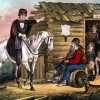
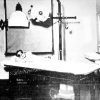
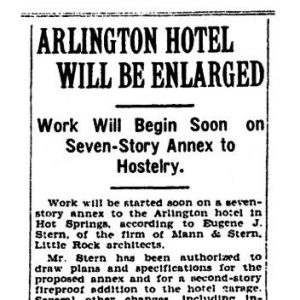 Arlington Hotel Enlargement Article
Arlington Hotel Enlargement Article 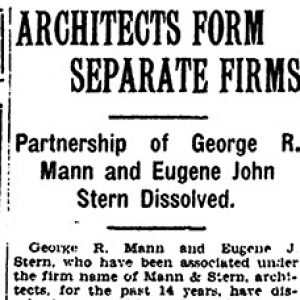 Mann and Stern Article
Mann and Stern Article 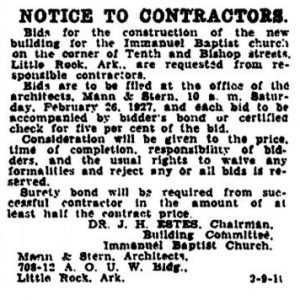 Mann & Stern Immanuel Baptist Bid Request
Mann & Stern Immanuel Baptist Bid Request 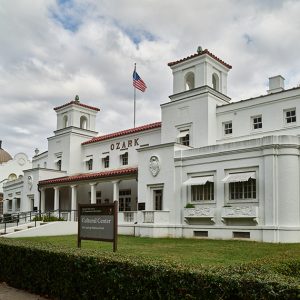 Ozark Bathhouse
Ozark Bathhouse 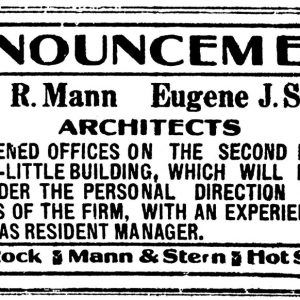 Mann and Stern Office Announcement
Mann and Stern Office Announcement  Eugene J. Stern
Eugene J. Stern  Eugene J. Stern Article
Eugene J. Stern Article  Stern Firm Announcement
Stern Firm Announcement  Stern Concrete Plant Ad
Stern Concrete Plant Ad  Stern Divorce Petition
Stern Divorce Petition 



Comments
No comments on this entry yet.